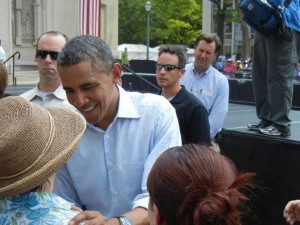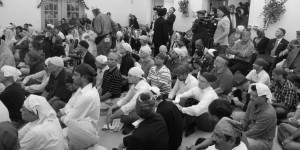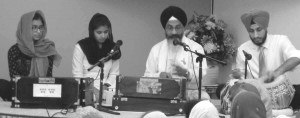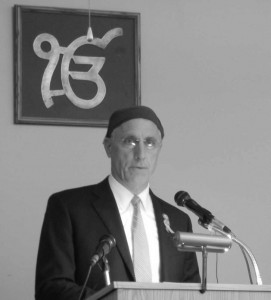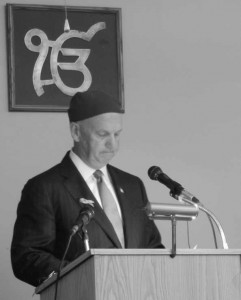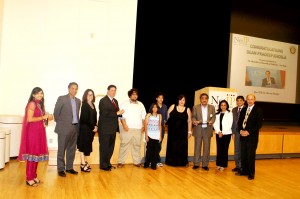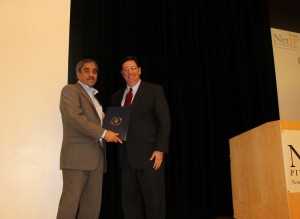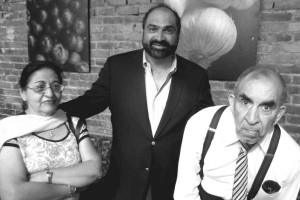Archive for category October 2012
Honestly, We Cannot Build Anything ALL BY OURSELVES!
Posted by admin in October 2012 on October 20, 2012
In the days leading up to their convention in August, Republicans perversely and cynically truncated President Obama’s words from this quote: “If you were successful, somebody along the line gave you some help. There was a great teacher somewhere in your life. Somebody helped to create this unbelievÂable American system that we have that allowed you to thrive. Somebody invested in roads and bridges. If you’ve got a business — you didn’t build that. Somebody else made that happen.â€
They twisted the word “that†totally out of context to imply Obama does not understand the American ethos built on free enterprise, subliminally telling their base Obama is a Closet Commie. They dedicated an entire day in their convention at Tampa taunting Democrats with the slogan “We Built That.†This was the cheapest cheap shot in political sloganeering in 2012.
This was jarring for most people. Yes, we work hard to earn our degrees, residencies, and fellowships; yes, we indiÂvidually build our careers and businesses with great commitment and dedication. And it’s true, over the years we’ve paid, and we will continue to pay, tens of thousands of dollars in income and other taxes. But most of us are also well compensated more than monetarily.
Of course we make valuable contributions as researchers, engineers, doctors and business owners. In accomplishing all these for which we are legitimately proud, we need to remember, we use the creations, services and skills of others, often taking them for granted—the supports that we did not create, but without which we simply can not accomplish all that we do. This is true for everybody in all well-organized societies.Â
Immigrants in the US would know this better.  They use the excellent roads, reliable communication services and EMS and the 911 system; tax-payer funded public education in high schools and public libraries; reliable professional services of auto mechanics, home repairmen, analytical labs that they can not get in many parts of the world from which the immigrants come… …
Besides, all of us Indian-Americans—even those who come from influenÂtial and powerful families of land owners, politicians, business people, officials in government and the private sectors in India—received highly subsidized, tax-payer-funded university education. We paid as tuition only a tiny fraction of what it costs to run the colleges. Those who got admission into US universities received teaching and research assistantships funded by Federal and State governments; fellowships and fee deferments from endowÂments established by individuals and corporations in universities.
While nothing of worth is ever achieved without the initiative and drive of the individual, it is outright vanity and pride –Â which are sinful in the Christian tradition, and which the Dharmic faiths warn, are sure to lead to man’s downfall –Â to claim or even believe that all our accomplishments are out of individual effort alone. Along the way, many lent us their shoulders for us to stand on.
Honestly, some of us have even stepped on others’ toes, or used our parents’ strong elbows, influence, and wealth in accomplishing our goals.
The Pittsburgh Gurudwara Organizes Vigil Against Hate Crimes
Posted by admin in October 2012 on October 20, 2012
On Sunday August 5th, at the Gurudwara (Sikh temple) in Oak Creek, Wisconsin at around 10:30 a.m., preparations were going on for the prayer service and the langaar when gunman Wade Page shot people inside and outside the place of worship. Police were called and before it was all over, six Sikh worshippers were killed by the gunman and 50 others wounded. The gunman Page was himself killed by the police. For the ignorant Page, filled with hatred, it did not matter that an overwhelming majority of Muslims in the US do not wear turban at all. Ignorance and hatred are always an incendiary combination in all situations.
Instantly, the sporadic tauntings and threats faced by turban-wearing Sikhs who were mistaken for Muslims in the US after September-11 got much-needed attention nationwide. All these years, the Sikhs handled the harassment and humiliations stoically, dealing with the local police privately all over the US.
That ordinary Muslims going about their daily lives are harassed is bad enough. But what to make of the terror-filled crime perpetrated by a hateful man inside a Gurudwara mistaking the Sikhs for Muslims?
Despite instant access to information in the US, that people still do not have a basic understanding about our demographic mix is a great irony of our time.
Understandably, the FBI got involved, calling the killings at the a hate crime based on ethnicity and faith. So, all over the country, vigils were held in Gurudwaras across the nation to mourn the killings of the Sikhs in Wisconsin. In Monroeville, on Saturday August 12, the Tri State Sikh Cultural Society held a meeting and a candlelight vigil at their Gurudwara to honor the dead and wounded in the violence at the Oak Creek Gurudwara.
The vigil was well-attended by members of the larger Pittsburgh community made up of Hindus, Christians, Jews, and Muslims. The diverse gathering at the Gurudwara in terms of faith and ethnicity was in itself a powerful antidote to what happened in Wisconsin.
The well-organized, dignified, and solemn ceremony was a balm not only to the Sikhs gathered in large numbers, but also for all others traumatized by this senseless violence.
The Gurudwara’s Granthi Shri Sucha Singh set the tone for the evening when he sang a mellifluous Kirtan (Sikh hymns from the Adi Granth, the Sikh Scriptural book). He recited and expanded one verse of  Guru Nanak that urges people to overÂcome hatred and enmity with love for fellow human beings.
Two young Sikhs born and raised in the US, Bani Kaur and Amar Singh, told the audience what it means to be a Sikh. Amar Singh gave the significance of the turban and why Sikh men wear them.
US Attorney David Hickton, representing the Department of Justice of the federal government spoke to the overflowing crowd at the Gurudwara briefly in measured tone. “[A]n attack on our civil rights or a hate crime is an attack on all of us, also an attack on our nation and our principles,†he said. He assured the audience that perpetrators of hate crimes will be dealt with the full force of the law.
Congressman Tim Murphy in his address said “We are not a nation of hate, we are a nation of love, and as such there is no room for hate in this room.†He promised to lend support to Sikhs to recover from this tragedy.
A representative of Gov. Corbett and a representaÂtive of Congressman Doyle and a pastor also addressed the gathering.
Later, in the open area outside, in a solemn ceremony people lit candles at the flagstaff of the Khalsa flag as the names of those slain were called out to the chants of “Wahe Guru! Wahe Khalsa!!â€
Then as is the custom in every Gurudwara all over the world, visitors were treated simple food — called langaar among Sikhs — that was shared by all gathered. The communal sharing of food among those visiting any Gurudwara is an importnat part of the Sikh faith. Â
The Sikhs living in Southwest Pennsylvania highlighting the tenets of their faith and tradition in a very solemn and heartfelt ceremony will be long remembered by all those who attended.
Chitratan Singh Sethi, member of the Executive Committee of the Gurudwara welcomed the gathering and offered the closing remarks.
Make Your Vote Count in November!
Posted by admin in October 2012 on October 20, 2012
By Ravi Balu, Murrysville, PA
e-mail: ravibalu@hotmail.com
Dr. Ravi Balu grew up in Pittsburgh in the 1970s, practices family dentistry in Murrysville. Ravi and his wife Raji settled in the city in 1990; since then he has been actively involved in the South Asian community as well as grass roots politics.
The November presidential election is likely to be a very close one, and whoever wins in Pennsylvania is likely to the next president. So, this is an appeal for all of you to go and vote on November 6.
Think back to our humble beginnings in the mid 1960s, when the Indian American community was made up of only a handful of families; most were pursuing their graduate studies, residencies at the local universities and hospitals, or working at Westinghouse. Fast forward fifty years: as South Asians, we are the third largest ethnic group in the greater Pittsburgh metÂropolitan area, after Caucasians and African Americans. The population of our community doubled from the 1990 to the 2000 census and is one of the well-recognized ethnic groups in the area.
Indian-Americans have made valuable contributions in many diverse fields in Western Pennsylvania—including performing and visual arts and veterinary medicine, not to speak of our presence in healthcare, engineering and technology, IT, research & teaching, the hospitality industry, architecture & civil engineering, and small and medium businesses.
Though we are relatively small in number, our community has contributed to making Pittsburgh one of the top ten most-livable cities having a vibrant housing and job market.
Therefore, we should have influential voices on how we govern ourselves—whether it is in city, municipal or county governments, state legislature, or in US Congress—to voice our concerns about school education, poverty alÂleviation, escalating costs in higher education and healthcare, urban growth, and opportunities for our kids’ futures.
It is wonderful to see that a number of our community members have taken the initiative to run in local elections. We should support them wholeheartedly, participate in electing local and state legislators, and members for the US Congress, not to speak of electing the next president.
So on November 6th, please go to vote and make a statement. You need to have eligibility to vote—natural or naturalized citizenship—and you should be registered to vote. For registering to vote, please visit your local post office to pick up an application.
If you are interested in getting involved with local campaigns or have any questions about registering to vote, please contact the U.S.-India Political Action Committee’s Pennsylvania chapter at www.usinpac-pa.com.
A New Indian Community Center Opens
Posted by admin in October 2012 on October 20, 2012
By Subhash Joon e-mail: sjoon@wowglobal.com
Subhash Joon was born in Rohtak area of Haryana, India and arrived in the US in 1998 on project for US Steel. He has done B.Tech from India and completed a small-MBA program at Pitt. After being an entrepreneur of an IT consulting company for ten years, Joon, with his wife Sarita Khatri, is now focusing on Nirvana Development, their real estate development/investment company. Subhash lives in Upper St Clair, PA.
While attending a dinner with several friends, someone said, “Temples are so far away for people who live southwest of Pittsburgh. Why don’t we have anything on this side of town where we can have Indian community programs and do the cultural things that temples offer?â€
That’s how it all started. There was certainly interest and need for people of Indian origin for a facility like a community center. Being in real estate investment and development for years, I always wanted to develop ideas outside commercial projects. I started talking to more people in the community to get some feedback, which turned out to be very positive.
The next step was to convince my wife of the idea and explain to her how we could develop an Indian center and perhaps name it “Karma Center.†The Indian center, we discussed, could have a banquet hall, an Indian restaurant, space for yoga and dance-type activities, including a small, unique type of Karma temple (maybe) without any priest or reliÂgious images.
After three years of hard work and substantial financial investments, we have finished the Indian Community Center (ICC) at Carnegie. During the development of the project, we brought in new passionate partners who helped grow the idea and who had experience in the restaurant industry. During the development process, we decided to convert the small Karma temple area into a library and a cultural hall to have more focus on educaÂtion and about Hindu living.
The ICC opened its doors to the public on Feb. 27th, 2012 at 205 Mary Street, Pittsburgh, PA. The phone number is (412) 278-5058. The ICC houses the Café Delhi restaurant, a large banquet facility, an Indian dance school, Yoga and meditation institute, and much more.
The ICC offers a free hall to community groups and individuals, proÂvided that the programs are for non-profit and community growth. We are excited to see the response from our community and how people are able to take advantage of the facility. We continue to work on new ideas and to start more programs in partnerships with our temples. You will see many more activities in the future, including a free medical clinic, a cultural school, and community round-up and growth programs.
I hope everyone will get to enjoy the activities at ICC and help educate our community and bring everyone together.n
Saadat Hasan Manto: The Almost Forgotten Literary Giant of India and Pakistan
Posted by admin in October 2012 on October 20, 2012
After 60 years of the bitter Partition, three wars, and the resulting carnage, people of India and Pakistan seem to be warming up to each other. In this background, I am pleased to inÂtroduce to readers a few Urdu literary figures of the Partition era. As you read these articles you would wonder if these writers belong to only one country or truly belong to both. I have chosen Sadat Hasan Manto for my first presentation.
Saadat Hasan Manto is one of the great story tellers of the Partition era. Manto, who spent thirty-six years in undivided India and seven years in Pakistan, truly had the great talent of telling stories as he saw them and writing the way he perceived human nature, emotion, and suffering. He made his readers shiver in cold chill and shocked them into pondering the inner depth of human emotions. He took them beyond the compulsions of crass politics, religious bigotries, and outward social changes. That made him one of the most controversial writers of his time and he paid dearly for that. His 100th birthday is being celebrated in both India and in Pakistan this year.
Formative Years: Manto’s childhood was rather common and undisÂtinguished, holding little promise of the greatness that awaited. He was born on May 11, 1912 in a typical middle class Muslim family of Samrala, in Ludhiana district of Punjab, India. He showed no interest in the studies at school. In fact, he failed twice in his matriculation examination in Urdu (!!) and he lacked any academic direction.
However, after a series of false starts, he came into his own as a writer after moving to Bombay in 1936 to edit a film magazine. The film world excited Manto’s imagination, but he wanted to create a new literary senÂsibility. Manto’s productive period began in 1941 in New Delhi with All India Radio. In eighteen months he published over four collections of radio plays, a few short story collections, and a collection of essays. He moved back to Bombay in July 1942 to work in the film industry again.
Partition and Anguish: The event that shook Manto’s confidence in himself and in his fellow human beings was the Partition of India in 1947. A humanist and secularist to the core, he was deeply saddened by the spectacle of violence let loose by the event; even his beloved cosmoÂpolitan city of Bombay and its film world could not remain immune. He left Bombay in a daze, heading to Lahore to be with his family. But the Bombay in him never left its place.
Life in Lahore: Soon after arriving in the nascent Pakistan, Manto initially wrote for some literary magazines. These were the days when his controversial stories like Khol Do (Open It) and Thanda Gosht (Cold Meat) created a furor among Pakistani conservatives. It resulted in the banning of his work. It was a mean blow to his livelihood.
To survive, Manto started writing indiscriminately in order to provide for his family. This changed him and Manto became a different person from the one who arrived from Bombay in 1948. The necessity to earn his livelihood consumed him very fast.
The absence of intellectual ambience and literary freedom, lack of support, financial worries, and constant harassment were of little help in his new life in Lahore. As a creative artist who went to Pakistan during Partition, he was not alone in getting disillusioned. A few of them even returned to India. The famous vocalist Bade Gulam Ali Khan and the left-leaning lyricist/poet Sahir Ludhyanvi are well-known among those who returned to India from Pakistan.
Disillusioned and lonely in a stifling land, he sought solace in alcohol and drank himself to death. Even in his misery, Manto gave some of his best writings to the literary world. It was during this period that he wrote some of his masterpieces.
Finally, peace came to him on January 15, 1955, only when he died.
Manto and Partition Stories: The awful events during Partition— nearly a million killed—traumatized writers on both sides to such an extent that for years no one dared to write openly about it. But not Manto.
Manto was among the few who observed the bloodbaths of Partition in both Bombay and Lahore with clinical and cynical eyes. He turned the Partition tragedies into great literature, even when the wound was raw in people’s consciousness. He wrote of violence seen from both victims’ and perpetrators’ perspectives, regardless of religious or caste identities. His many stories brought into sharp relief the contradiction, passion, fear and irrationality among Hindus, Muslims and Sikhs in India, which quickly led them to sink into brutality towards fellow human beings with whom they have lived for centuries.
What Manto recorded was, in the words of his grandniece Ayesha Jalal, a historian and Professor of History at Tufts University, “Neither human zeal nor piety, but human greed and man’s astonishing capacity for bestiality that had brought the subcontinent to such a sorry pass.†(To be continued …with Partition stories in next issue).
Pittsburgh’s Muralidhar* Ajit Ranganathan Returns to India
Posted by admin in October 2012 on October 20, 2012
By Kalyani Raghavan, Edgewood, PA
* Muralidhar in Sanskrit literally means “The one who holds a bamboo flute.â€
Ajit Ranganathan, whose mellifluous bamboo flute has entertained many lay and seasoned listeners of Indian classical music for over sixteen years here, has moved back to India on a career change.
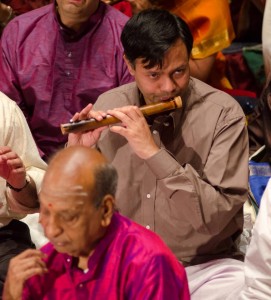
Ajit Ranganathan in the Clevelend Tyagaraja Music Festival . The Flute Maestro N. Ramani in the foreground. Photo: Usha Raghu.
Hailing from the temple town of Srirangam in Tamil Nadu, Ajit got his Electrical Engineering degree from Anna University, Chennai. He earned his masÂters’ degree in electrical and computer engineering from New York University, Buffalo.
In India, he had initial training on the flute from Srimathi N. Kesi, a disciple of the flute legend T.R. Mahalingam (Mali). After coming to Pittsburgh, Ajit, a regular at the annual Cleveland Tyagaraja Music Festival, fine-tuned his technique from the maestro Sri N. Ramani. Ajit has played with Ramani on several occasions at the Cleveland Festival.
In addition to giving full-length recitals in Pittsburgh at S.V.Temple and in Oakland, Ajit has unstintingly helped organizers who approached him for short recitals in their programs. He performed in the Indian Nationality Room dedication function in 2000 at the University of Pittsburgh and also during the opening day of the TropiÂcal Forest India exhibit at the Phipps Conservatory in 2011.
People have enjoyed his recital in the India Day celebration at the CaÂthedral of Leaning, particularly during the initial years when the organizers were struggling to increase participation. He has played countless times every year as part of live orchestra all over the USA.
Ajit has been a vital part of the cultural activities at the S.V.Temple for years, where he was the Chairperson for the Cultural Committee and also its Treasurer. He regularly participated in the temple’s music festivals and during Navaratri. He is well-versed in many classical Sanskrit and Tamil devotional hymns.
Those who have interacted with him have always noticed Ajit’s unasÂsuming demeanor. He always dressed in traditional white dhoti for all religious and music functions at the temple. We will miss not just his musical talents, but also his gentlemanly smiling presence. Most probÂably, we will see Ajit again in the US when he comes on business trips or work, or for giving flute recitals.
Who knows? He may even move back to the US. For now, we wish him well, and thank him for enriching our cultural life in Pittsburgh.
Universal Love for Humanity
Posted by admin in October 2012 on October 20, 2012
By Kris Gopal
e-mail: gutcut@comcast.net
I wish to share a few refreshingly impressive observations during my recent visit to India this year. Though I could have shared other experiences in India, what follows made such deep impressions that I am compelled to share it with you. This is about my visit to an institution built around the idea of universal love.
This love, I felt durÂing my visit to PuttaÂparti, a small village in Anantapur District in Andhra Pradesh, about 120 miles from ChenÂnai, and the same disÂtance from Bangalore. This is the place where the late Sri Sathya Sai Baba lived, and where he established an ashÂram Prasanthi Nilayam (Abode of Supreme Peace). Many of you would have heard of him and this place.
This article is not about him or his spiritual powers, but about his viÂsion and devotion to humanity. The Baba integrated the unique Hindu concept of Unity of Faiths — “All roads lead to the same hilltop,†and service to people in need. His motto was “Hands that help are holier than the lips that pray,†echoing the words of Rabindranath Tagore.
At some point in his journey through life, Sai Baba Health was influÂenced by the credo that education and abundant supply of drinking water are inalienable rights of every individual irrespective of race, religion, caste, and creed. Imagine for a moment that you are poor, and imagine getting all these free, yes free. It is available in Puttaparti, all due to the influence Sai Baba had over his resourceful followers, and his commitment to selfless love and compassion.
Education: Education in schools and colleges he built is a holistic one emphasizing human values. The institutions provide education from the primary school level right up to the postdoctoral level. The curriculum offered in these institutions is so successful that now over ninety countries are adapting this system to their situations. The school of higher learnÂing here is listed as as one of the top four universities accredited by the NAAC (National Accreditation of Assessment Committee). There are about 350,000 children enrolled in Bal Vikas schools now, and over one million youngsters have graduated from Bal Vikas schools. Over one hunÂdred schools are in operation.
No fees whatsoever are charged to the students in these institutions. Such a value-based free education system is spreading to surrounding areas and other states also — a very refreshing and fascinating change, indeed!
Health Care: Even for an economic superpower like USA, the idea of a free and universally accessible health care system for all citizens is unthinkÂable, but universal health coverage is very obvious here at Puttaparti, with a network of general hospitals, super-specialty hospitals, mobile medical hospitals, and medical camps, at no-cost to the patients.
Every patient, irrespective of religion, economic or social background, receives fairly comprehensive state-of-the-art medical care and with unÂconditional love. The medical care is provided in these institutions both as outpatient and in-patient.
Major surgeries are done here with adequate postoperative and prevenÂtive care. One Super Specialty hospital was opened in Puttaparti with about 300 beds in 1991 in a sprawling 153,000 sq. ft. facility. To this day they have treated more than 3 million patients, all free.
As I walked through this hospital, I was impressed by its vastness. The facility was clean, which I have not seen even in many high-priced Indian hospitals. Another striking feature is that all healthcare records are electroniÂcally stored and accessed with no need for paper trails. The USA has been struggling hard to go paperless for years and is far from achieving it.
The hospital does provide their performance stats including death rates, complications rates, and they also maintain all other quality measures. I reviewed them, since I had access, and it was astounding, comparable to any other well-kept hospital anywhere in the world.
A second super specialty hospital has opened in Bangalore near WhiteÂfield in 2001. Both of them complement each other and provide care for the local people. This is also totally free.
By early 2011 these two hospitals had conducted over 95,000 cardiac surgeries, over 56,000 urology and plastic surgeries, 55,000 eye surgerÂies, and nearly 13,000 neurological surgeries and over 6,000 orthopedic surgeries since inception, all of it free of cost to patients.
Taking inspiration from this magnanimity, a few private medical faciliÂties in and around Chennai are trying their bit to provide free healthcare to low-income people. Several institutions are opening up to free health care, which is really a good change.
Drinking Water: The Rayalaseema region is the hottest dry belt in Andhra Pradesh with many villages having no access to even drinking water. Thanks to Satya Sai Baba, now at the cost of Rs. 3,000 million, about 731 villages in this area have abundant water supply both for doÂmestic purposes and for irrigation. The four major water projects have laid 5020 kilometers (3100 miles) of pipeline so far.
This one man Satya Sai Baba’s compassion and love for his fellow human beings have found their way into millions of hearts in India and abroad. Organizations have sprung up in 125 other countries wanting to spread this type of love on humanity. He lived what he preached: “Selfless love is the source of happiness, truth, peace, sacrifice, endurance and all the higher values of life. Love is the most fundamental moral value.â€
Vignette from Indian Literature — Challenges in Being Mindful
Posted by admin in October 2012 on October 20, 2012
I remember in my teens my older brother who raised me yelling at me while I was reading a Tamil weekly. I did not respond, not out of disrespect — that was simply not an option — but only because I did not hear him. Any explanation would have only made the matter worse. So I meekly went about doing the chore I should have done days earlier.
Only when I became an adult did I realize that when we are fully enÂgrossed in whatever we do and fully engaged in that one activity, we forget about ourselves and our surroundings. Examples: struggling to understand a difficult subject, or fully immersed in singing practice, landscape paintÂing, or during the critical stages in cooking.
Pilots during landings and takeoffs are so fully engaged in what they do, they forget about everything else. Surgeons during the critical stages while performing their “procedures†do not hear the piped music in the operating room.
In the Buddhist tradition this faculty is called Sati or mindfulness. It is the state of being fully engrossed in our present moment, and not doing things mindlessly like an automaton. This faculty, acquired by pracÂtice and emphasized in all “Dharmic†religious traditions that originated in India, is the foundation of all Asian meditation practices, whether it is Hindu, Buddhist, Jain, or Sikh.
As is the case with anything worthy of accomplishing, recognizing the difficulty in being mindful is the first step to become fully mindful. Pattinattar, the 10th century Saivite mendicant and ascetic poet puts this nicely in self-deprecating humor. Here is his 4-line alliterating and rhymÂing verse* in Tamil:
Here is a non-poetic translation:
O, The One Who Destroys the Burden of [people’s] Karma, How can You accept my Puja (worship) done while My hands do one thing, eyes follow another object; The mind chases after yet another thing, And the treacherous tongue lies in whatever it says; The body made of flesh goes after something else, And ears listen only to what they want to hear? How can You accept my worship [done with so many distractions]?Pattinattar’s technique of composing the verse in the first person — How can You accept my worship… My hand etc. — also makes it non-judgmental in the minds of readers.
If he had composed the verse in second person singular (your hands, your mind, etc), it is condescending and intimidating. However, by composing in the first person singular, he takes the sting out of it, thus giving hope for people struggling with distractions.
Pattinattar is not alone here. Many of the Indian Bhakti poets, including Adi Shankara, Kabir and many others have used this technique.
*Source: Pattinattaar Paadalgal —Vilakkavurai by Thiru Vi. Ka. Gangai Puttaga Nilayam, Chennai 2006.
Mental Health Issues Among Indians Discussed
Posted by admin in October 2012 on October 20, 2012
— By Premlata Venkataraman
On June 16th at the SV Temple, a meeting was convened by Dr. Balwant Dixit through the efforts of the Temple’s Education commitÂtee and discussed the inconvenient topic of mental health and substance abuse in the Indian Diaspora here. Bringing this discussion into the open was a refreshing beginning, given the social prudishness of Indians and institutional prudishness of our temples.
It was a difficult topic for the 25-plus people in the audience to listen to. But the speakers – practicing psychologists, psychiatrists, and people who have dealt with the problems in their families — were open and candid, and did not mince words.
Mental health and substance abuse issues being problems often swept under the carpet in our community, the speakers tried to bring awareÂness to these serious afflictions by reassuring people that they should not hesitate to seek support in dealing with thes problems.
Dixit, who teaches pharmacology at the University of Pittsburgh, put together a panel of professionals from within the Indian community to bring cultural sensitivity to the afflictions of mental illness within the Diaspora. The panel members were Vishwajit Nimgaonkar, professor of psychiatry and human genetics in the School of Medicine at UPMC; Ranita Basu, psychiatrist at the Veterans Affairs Pittsburgh Healthcare Systems; and Anagha Manohar with a background in social work.
Dixit shared his findings on the statistics on mental illness (bipolar disorders, schizophrenia and others): 6% to 7% of the population in India suffers from mental illnesses. With the social rejection of people suffering mental disorders, more than 70% of those who suffer often deny that they even have a problem. Alcohol abuse is a big problem among Indians.
Dr. Nimgaonkar stressed the complexity of treating mental disorÂders. Recounting his own difficulty to stop smoking, he cautioned on the stronghold addiction has on the psyche of people. It requires great determination and support from family and community, and often mediÂcines to overcome the dependency.
On substance abuse, Anagha Manohar, with her background in soÂcial work, emphasized that communication and vigilance on the part of parents are critical to guide young adults to avoid addiction.
One speaker who brought poignancy to the situation was Ram Eyyunni, co-founder of “Mothers Cry.†He described the travails of his family as his son was diagnosed with schizophrenia at a young age and their attempts to care for him at home. He emphasized the role of the community and the support system it provides to bring relief for families dealing deal with this problem. Mothers Cry strives to bring awareness to the struggles of families in caring for the mentally challenged and in finding better facilities to help them cope.
The talks and the discussions were effective in throwing light on a topic that many do not like to discuss but which needs to be understood.
Editor’s end note: In discussing addiction one topic was conspicuously absent. That was the role of mind, mindfulness and consciousness and how they can be used in managing recovery from addictions. Researchers have recognized the synergy of medical intervention, family nand community support, and mental training in helping people recover from addictions. It is worth recalling this:
* mana eva manushyaanaam kaaranam bandha mokshayoh. (Sankskrit)
“Mind alone is the cause for both the bondage and liberation of humans.â€
— Amrita Bindu Upanishad
Send Off to Prof. Pradeep Khosla
Posted by admin in October 2012 on October 20, 2012
By Khyati Dave
Professional Chair and National Liaison Officer, NetIP-Pittsburgh
e-mail: khyati@netip-pittsburgh.org
Network of Indian Professionals (NetIP) of Pittsburgh on July 14 bid farewell to Prof. Pradeep Khosla through the Indian Community Impact Award Reception held at CMU. Dr. Khosla, after serving as Dean of the College of Engineering at CarnÂegie Mellon University, has taken up position as Chancellor of University of California, San Diego.
As an engineering alumna of CMU inspired by Dr Khosla, I wanted the younger generation to hear the story of his journey. So NetIP organized the farewell with help from the Indian GradÂuate Student Association at CMU and guidance from Dr. Kanak Iyer (CEO of Kanakadhara Financials). Several speakers including Sunil Wadhwani, CEO, iGate Corp and his wife Nita; Audrey Russo CEO, Pittsburgh Tech Council; CMU’s Provost Mark Kamlet; Heinz College’s Dean Krishnan; and Lalit Choradia, CEO Thar Technologies. They talked about Prof. KhoÂsla’s accomplishments and shared anecdotes of their interactions with him. Earthspring Media and Cylab’s film on Dr. KhoÂsla’s career highlights was also screened.
Mr. Bill Peduto, member of Pittsburgh City Council, gave the city proclamation to Dr. Khosla declaring July 14th as Pradeep KhoÂsla day. Dr. Khosla was awarded the 2012 Indian community impact award, a Steuben crystal sculpture designed by Robert Cassetti. It represented a metaphoric bridge suggesting a partnership between equals based on shared values and ideals. With the Indian and the American flags and the Pittsburgh city skyline engraved on a black granite mount, it was an appropriate award to Dr. Khosla — the link between Indian and American education systems. n
Book Review: What it takes to run a restaurant?
Posted by admin in October 2012 on October 20, 2012
Restaurant-411 A Book for Restaurant Goers by Bikki Kochhar 109 pp. Self-published. $14.95 For copies, contact 412 825 6599.
If you want to know everything about opening and running a restauÂrant, here is a book by Bikram Kochhar, who has seen it all. He has successfully run many “ethnic†restaurants—Indian, French, Mexican, Chinese, Thai, even fusion—for years. Known as Bikki, Kochhar partnered with people of diverse backgrounds in running these restaurants. Once, after buying a vacant restaurant, he had the gall to publicize that the restaurant would open in a week, and he did open it in time!
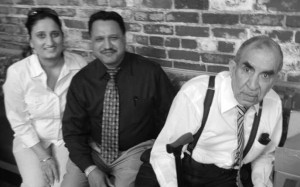
Kochhar (far right) with Manjit Kaur and Didar Singh during the book release. Singh, owner of Bombay Food Market, has partnered with Kochhar in the restaurant business.
Bikki is a quintessential entrepreÂneur. Born and raised in India to affluent parents who were in real estate and the hospitality industry in Shimla, he visits Pittsburgh scouting how this “land of opportunity†really was. Deeply impressed with the America he saw then, he returns to India, convinces his middle class wife to leave everything—even their two kids with his parents in India—and leave for the US with him. Landing in Pittsburgh, he realizes, “I had to work for a living.†Working as a manager in a leading hotel downtown, he sees the power of the union and the media first hand. His wife, who has never worked outside before, works in a restaurant as a cook. After burning his first payÂcheck taking his wife to an expensive dining spot in town, they live on eggs and toast for dinner for days! That is how his life starts.
He learned important lessons after making lots of mistakes, of course! Now in the autumn of his life, he has put all the pointers in a self-published book, taking help from his daughter Benita and grandÂson Nitesh, who spent “lots of frustrating but enjoyable time†working with Bikki and on his difficult-to-read hand-written manuscript.
Even though this is a “How-To†book for the restaurant business, many pointers are useful for businesses marketing nonquantifiable prodÂucts/services to temperamental customers. And the book is an easy read with humorous quotes and anecdotes — By K S Venkataraman
Ha! On the Office of US Veeps
Posted by admin in October 2012 on October 20, 2012
Despite the hoopla surrounding the choice and announcement of Veep candidates in American politics, the occupiers of the Office of Vice President in the US, once settled in office, often do not have nice things to say about the very office they hold.
John Adams, the nation’s first Veep said this on the office of the US Vice President: “The most insignificant office that ever the invention of man contrived.â€
Many presidents made matters worse by ignoring or belittling their vice presidents. President Herbert Hoover didn’t even mention his vice President Curtis in his inaugural address.
l Adlai Stevenson, the veep for president Grover Cleveland, was once asked if President Cleveland had consulted him about anything of even minor consequence. “Not yet,†he said. “But there are still a few weeks of my term remaining.â€
In the 2012 election cycle, Paul Ryan, the Republican Veep candidate and a health nut among the GOP members of Congress, in a radio interview exaggerated his athletic prowess by claiming that he did the 26.3-mile marathon under 3 hours. The three-hour bench mark is a very big deal among Marathon runners. It turns out that Ryan was off by nearly 33%. His actual timing was more like 4 hours.
Nelson Rockefeller, given little but ceremonial duties by President Ford, said of his job: “I go to funerals. I go to earthquakes.â€
Dick Cheney, who was an exception in weilding power behind the scene under his oblivious Bush-43, earned notoriety for shooting a friend in the face when he went quail hunting. Dan Quayle, George H W Bush’s veep, on camera, incorrectly corrected an elementary school kid who spelled potato correctly. Veep Quayle corrected the kid by adding an “e†at the end as “Potatoe.â€
Thomas Marshall, Woodrow Wilson’s veep said this “ There were two brothers. One ran away to sea, the other was elected vice president, and nothing was ever heard of either of them again.â€
Daniel Webster was a powerful conservative politician in the mid 19th century. He was a member of the House of Representative, a US senator, and also the Secretary of State during his political career. Having seen the glorified hollowness of the office, he is said to have declined the offer to be the veep with this gem: “I do not propose to be buried until I am really dead and in my coffin.â€
Sources: Wikipedia and Smithsonian.com.

